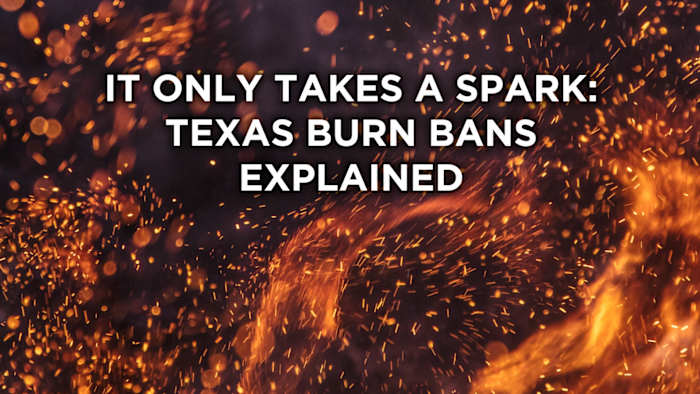Last week, Harris County was added to the growing list of areas under a burn ban. With weeks of dry weather and warm temperatures, fire danger has steadily increased across southeast Texas. In fact, most of us haven’t seen any measurable rain in nearly a month, 27 days and counting. That kind of stretch dries out vegetation, creating perfect conditions for wildfires to spark and spread quickly. As you can see in the image below, nearly all of southeast Texas is now under a burn ban.
Updated October 20, 2025 (Copyright 2025 by KPRC Click2Houston – All rights reserved.)What causes a burn ban?
It all comes down to how much moisture is left in our vegetation. One of the main tools used to measure this is the Keetch-Byram Drought Index, or KBDI for short. It helps estimate wildfire potential by tracking how much moisture the soil has lost.
The index works like a daily water balance; it factors in rainfall, soil moisture, and how much water the ground can hold (about 8 inches). The scale runs from 0 to 800: a reading of 0 means the soil is fully saturated, while 800 means it’s completely dry.
When the KBDI climbs into the higher range, even simple activities like mowing, grilling, or driving over dry grass can spark a fire. Right now, several areas from San Antonio and Austin to Houston and Beaumont are pegging near that 800 mark, some of the driest readings possible.
This index shows how much moisture is in vegetation (Copyright 2025 by KPRC Click2Houston – All rights reserved.)We have a burn ban, now what?
You might think a burn ban means no burning at all, but there are exceptions.
The ban prohibits all outdoor burning unless it’s done inside an enclosure that completely contains flames and sparks. Violating the ban is no small matter, it’s a Class C misdemeanor that can carry fines of up to $500, and more serious charges if your fire causes damage.
What is allowed:
TCEQ-authorized burns
Approved ceremonial fires
Backyard grilling (non-commercial use)
Welding and other “hot work”, as long as it follows county fire code regulations
Diwali fireworks are allowed, but under strict restrictions to reduce fire risk. Fireworks may be sold, but vendors cannot sell skyrockets with sticks or missiles with fins.
Fire feeds on careless deeds:
The science behind fire danger is simple, when it’s dry and warm, the risk goes up. But whether a fire actually starts often comes down to human behavior. Do your part, and fire won’t start.
Even if you’re not burning outdoors, activities like grilling, smoking, or lawn maintenance can still pose a risk. Here’s how to stay safe:
Outdoor cooking safety
Keep your grill off dry grass or vegetation, a stray spark can ignite a fire fast.
Never add charcoal starter fluid after the grill is lit.
When you’re done grilling, let coals cool completely, then soak them in water and dispose of them in a metal container.
Properly discard smoking materials
Never toss a lit cigarette or butt out your car window, it can easily land on dry grass and start a fire.
Don’t discard cigarettes in mulch, potted plants, or landscaping, all can ignite quickly.
Lawn & vehicle safety
Lawnmowers are made for lawns, not tall weeds or dry grass. Metal blades hitting rocks can create sparks.
Avoid driving through or parking on dry grass, hot exhaust systems can ignite dry vegetation.
Make sure trailer safety chains aren’t dragging, they can spark roadside fires.
If you see a fire:
All fires start small. If you spot an unattended fire, call 9-1-1 immediately. In these dry conditions, even a small flame can spread quickly and threaten lives and property.
How much rain we need, the problem and the drought (KPRC 2 TV)Our weather outlook:
The problem is clear when you look at the graphic above, with the exception of our southwestern counties, most of us need 8 to 12 inches of rain to erase this growing drought.
Our elevated fire danger comes from a mix of heat and dry vegetation, which acts as fuel. The good news? This time of year, our winds typically stay light, and that’s helping limit fire spread. We’ve seen a few grass fires recently, but nothing major so far.
Looking ahead, a pair of cold fronts over the next 10 days could bring up to an inch of rain for parts of Southeast Texas. Unfortunately, the longer-term outlook for November still points to drier-than-normal conditions.
For now, we’re stuck in a dry pattern, but I’ll keep you posted when there’s a sign of change and the rain finally makes a comeback.
Anthony’s Weather Lab
More Stories Like This In Our Email Newsletter
Copyright 2025 by KPRC Click2Houston – All rights reserved.

